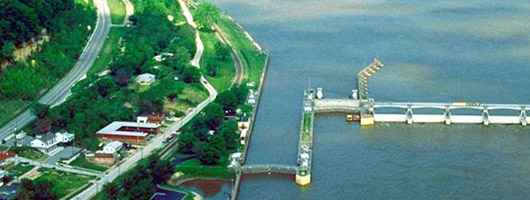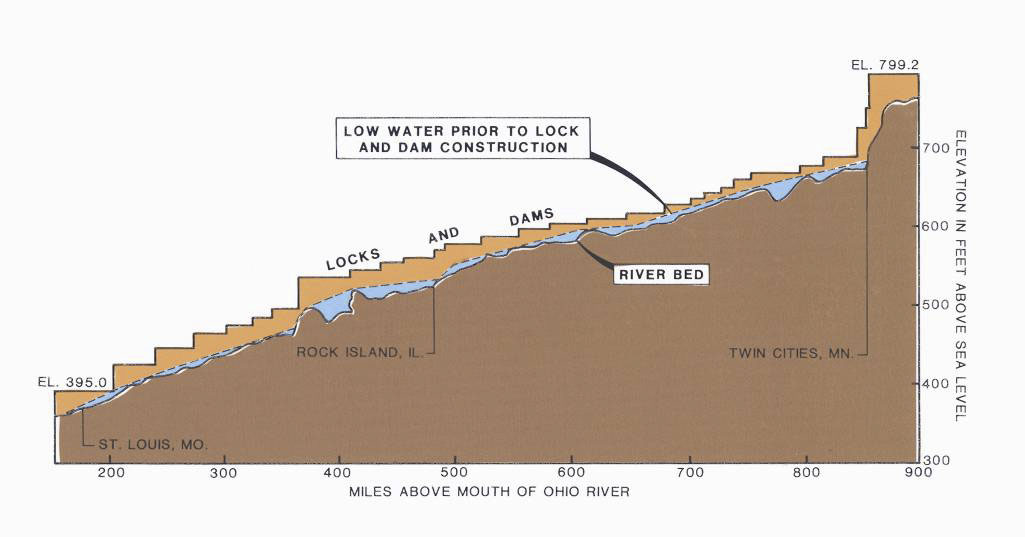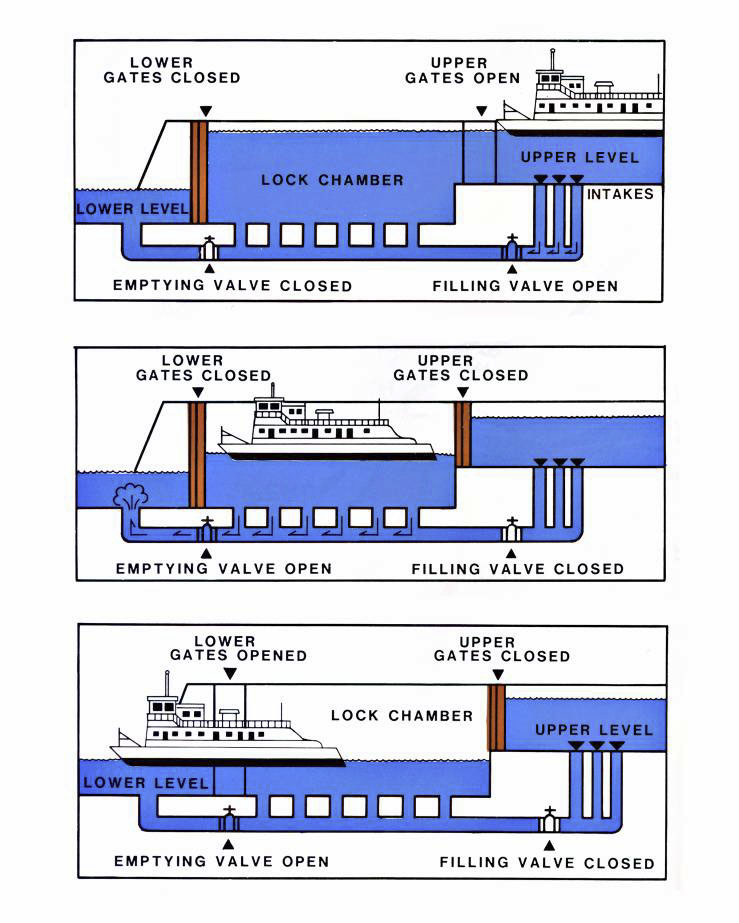
Lock & Dam 24
Construction on Lock and Dam 24 began on July 20, 1936 and was finished on March 12, 1940. A major rehab of the lock and dam was completed in 2005. This work consisted of replacing a large portion of the concrete in the lock chamber walls, walkways and work areas. Also, new gate and valve machinery was installed elevating the electrical components above the 1993 flood levels.
The dam consists of 15 fully submersible tainter gates. These gates pivot vertically to control water flow. In times of high water, these gates are raised completely and the river flows almost unimpeded, allowing a more natural flow of the river.
The lock chamber is only big enough for a half size tow (a normal tow is one towboat pushing 15 barges). The barges going through this lock must perform a double lockage. During a double lockage, the first set of barges (up to nine) are disconnected and put through the lock chamber. Since these barges are no longer connected to a towboat, they are pulled through using a tow-haulage (cable and hoist system). After the barges are locked through, the rest of the tow locks through and rejoins its entire load. This process can take up to two hours to complete. Recreational boats must also lock through the lock on their journeys up or down the river.
Vital Statistics
| Location: | Clarksville, Mo. |
|---|---|
| Mississippi River Mile: | 273.4 |
| 1st Day of Operation: | Mar. 12, 1940 |
| Average lift: | 15 feet |
| Pool size: | 29,750 Acre Feet |
| Pool length: | 27.8 miles |
| Lock characteristics: |
Single Lock, 600 feet long, 110 feet wide |
| Dam Characteristics: |
1,340 feet long, 15 Tainter Gates |
| Phone number: | (573) 242-3524 |
| Marine Radio: | 14 |
Nine-Foot Navigation Channel
Located in Clarksville, Missouri, Lock and Dam 24 is part of the Upper Mississippi River Nine Foot Navigation Project. The Project, authorized by the Rivers and Harbors Act of 1930, created and ensured a nine-foot deep navigational river channel.
On the upper Mississippi River, a total of 29 lock and dam systems were constructed, forming a stairway of water from Minnesota to Illinois. From the first lock and dam at Minneapolis-St. Paul, Minnesota to the last one at Granite City, Illinois, there is a drop in elevation of 420 feet. The locks are necessary at each of the dams to allow boats to navigate from one pool (the water backed up behind each dam) to the next. These locks were constructed to aid in navigation only, they were not designed for flood control.
On the lower Mississippi, the river does not need locks and dams because, with the addition of the Missouri, Illinois, Arkansas, Ohio, and other rivers, it is naturally wide enough and deep enough for navigation.

Locking Process
The lock chamber consists of four miter gates (two at each end of the chamber), and four valves (two at each end). All boats wishing to pass through a dam must lock through the lock chamber, even during open river conditions.
Lockage is completed by using a system of valves to raise and lower the water level in the lock chamber. This is an elevator system for boats, raising or lowering them to the same level as the pool they want to get to. There are two sets of valves, the filling valves (located at the upper pool) and the emptying valves (located at the lower pool). The filling valves are opened to allow water to enter the chamber, making it the same height as the upper pool, and the emptying valves are opened to allow water to drain out, making the chamber the same height as the lower pool. During the process, no pumps are used; the chamber is operated solely on gravity.

Annual Tonnage
| Year | Tonnage | Lockages |
|---|---|---|
| 2009 |
26,682,701 |
4,282 |
| 2008 |
23,133,551 |
3,616 |
| 2007 |
30,145,700 |
4,816 |
| 2006 |
31,061,559 |
4,642 |
2005 |
28,932,976 |
4,403 |
2004 |
27,883,604 |
4,370 |
2003 |
33,761,938 |
5,268 |
2002 |
38,864,614 |
6,196 |
2001 |
34,785,352 |
5,601 |
2000 |
38,697,993 |
6,282 |
1999 |
39,296,994 |
6,504 |
1998 |
34,747,480 |
5,767 |
1997 |
33,614,330 |
5,835 |
1996 |
36,181,599 |
6,481 |
1995 |
37,540,528 |
6,537 |
1994 |
30,735,288 |
5,331 |
1993 |
26,581,272 |
4,657 |
1992 |
39,423,782 |
7,078 |
1991 |
37,595,771 |
6,897 |
1990 |
42,352,920 |
7,670 |
1989 |
36,137,676 |
6,719 |
1988 |
37,885,828 |
7,060 |
1987 |
35,313,874 |
6,459 |
1986 |
28,162,425 |
5,199 |
1985 |
26,101,054 |
5,040 |
1984 |
35,962,865 |
6,536 |
1983 |
37,345,441 |
7,039 |
1982 |
32,731,049 |
6,264 |
1981 |
34,002,095 |
6,729 |
1980 |
32,731,049 |
6,601 |
1979 |
28,562,788 |
Na |
1978 |
28,928,612 |
5,893 |
1977 |
25,057,500 |
5,248 |
1976 |
24,588,373 |
5,386 |
1975 |
23,713,451 |
5,058 |
1974 |
24,522,995 |
5,157 |
1973 |
22,940,935 |
4,914 |
1972 |
24,941,149 |
5,384 |
1971 |
21,563,788 |
5,250 |
1970 |
22,209,505 |
4,938 |
1969 |
18,371,594 |
4,344 |
1968 |
16,663,104 |
4,688 |
1967 |
16,312,126 |
4,211 |
1966 |
15,915,016 |
4,078 |
1965 |
13,312,470 |
3,585 |
1964 |
13,312,470 |
4,084 |
1963 |
12,611,627 |
3,827 |
1962 |
10,865,245 |
3,801 |
1961 |
9,638,452 |
3,367 |
1960 |
9,711,261 |
3,408 |
1959 |
9,180,898 |
3,398 |
1958 |
8,446,256 |
3,386 |
1957 |
7,437,070 |
3,288 |
1956 |
6,783,763 |
3,146 |
1955 |
6,505,230 |
2,001 |
1954 |
5,649,694 |
2,437 |
1953 |
5,053,533 |
2,337 |
1952 |
4,042,095 |
2,028 |
1951 |
4,199,346 |
1,991 |
1950 |
4,305,665 |
2,260 |
1949 |
3,645,372 |
2,553 |
1948 |
3,224,357 |
2,179 |
1947 |
3,149,689 |
1,706 |
1946 |
2,977,872 |
1,818 |
1945 |
2,029,925 |
1,214 |
1944 |
1,878,290 |
1,120 |
1943 |
1,669,539 |
1,051 |
1942 |
1,968,730 |
1,410 |
1941 |
1,975,878 |
2,214 |
1940 |
1,578,624 |
1,719 |
